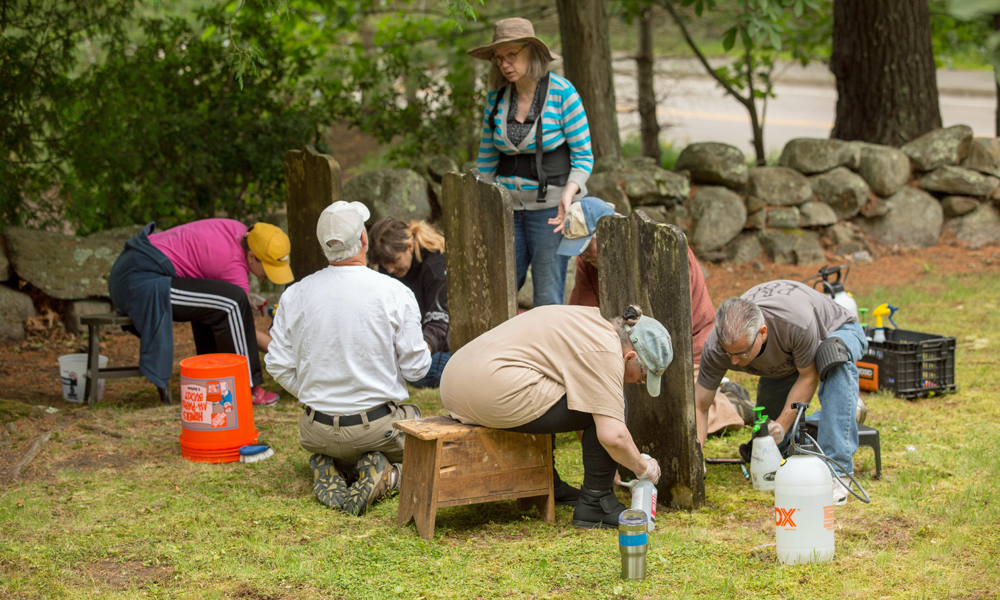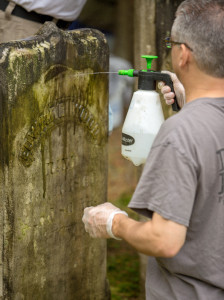True Tales: Cleaning the Face of History
By George T. Comeau
Volunteers worked in teams to clean the marble graves that date to as early as 1849 and belong to members of the Wood family. (George Comeau photo)
You are never really finished honoring the dead. Long after they are gone, our ancestors, both actual and inherited, are given respect and devotion. In Canton, the earliest of our founding families are buried in a small cemetery on Washington Street. And over the past several months we have been honoring our pioneer families. It is our moral imperative, and the Canton Historical Commission, in partnership with the Canton Historical Society, is working with toothbrush in hand to preserve the past.
This cemetery sits on a small hill in Ponkapoag. In 1690, when the first English settlers arrived, the landscape was quite different than today. The land in the early 17th century has been described as a “majestic forest.” When the settlers began squatting on the native land, they began clearing vast swaths of timber to build houses, outbuildings and meetinghouses. As the earliest development of what is now Canton occurred from the foot of the Great Blue Hill and moved southward to the upper plateau overlooking the Neponset Valley, the center of the town was where present-day Turnpike and Washington streets intersect.
There is no record of a meetinghouse, but we do believe one to have been “between Ponkapoag Village and Aunt Katy’s Brook.” The brook is still there — look carefully as you wait for the light at Route 138, just to your right as you head up the hill there is a small stream running under Washington Street. That brook is named for Miss Katy Blackman, whose ancestors are all buried at the back of the cemetery on the hill. Before the watercourse was named for Blackman, it was known as Spring Brook and would have been a natural source of water for the small community of settlers. We also know that the Ponkapoag Indians would have had an English meetinghouse in the vicinity. I have a theory that it was located closer to where Chapman Street is today, but other historians disagree and claim it to be closer to the graveyard.
In any case, there would have been a meetinghouse associated with the cemetery. In 1707 the inhabitants were ordered to build a new meetinghouse, and they constructed one where Canton Corner Cemetery is today. This is how we know there was a prior building somewhere near Ponkapoag. We certainly know there are graves. The earliest of our dead would have been buried here 326 years ago. Today we are restoring that place.
It is, actually, two cemeteries. The small parcel was under two deeds and separate ownership for most of the 18th and 19th centuries. There is no dividing line, but it’s easy to figure out approximately where the two are divided. The back half measures roughly a quarter of an acre and was deeded to two families in 1741. The deed was taken by John Puffer and Benjamin Blackman and their associates. The deed also refers to the fact that it has been known as a burying place for more than 30 years. This sacred place became known as “The Proprietors’ Lot.”
At the top of the hill few graves have survived. The earliest would have only had rough field stones to mark them. In the late 19th century most of the oldest gravestones had already slipped into obscurity. Kind hands would take the fallen stones and lean them up against the stone wall that encircles this place. Eventually the fragments would shatter and now small piles of slate have crumbled along the borders of the cemetery.
The second cemetery, the one closest to the road, was known as the English Graveyard. This front half of the land was owned by Jonathan Kenney, and in 1754 he gave this land to “The Society for the Propagation of the Gospel in Foreign Parts.” Incorporated in 1701, the society was a missionary arm of the Anglican Church, and as New England moved to a more Congregational church form, the holdouts for a more traditional Anglican Church turned to the society. It is here that the family of Samuel Spare is buried. There is a large lot and monument dedicated to this old family that came here in 1738.
Taken as a whole, this beautiful and sacred spot has been largely unseen for decades. For one thing, it’s very hard to visit. You have to park on a nearby side street and walk carefully along the edge of the road where there is no sidewalk. The town has owned both lots since approximately 1806, but no deed has been found to bear this out. Nonetheless, we as a community have been caring for this place in fits and starts ever since. In 1818 the “wall was tumbling down; the trees were leaning against the old moss-covered stones and cracking them.” The town appropriated a small sum of money to “fence the land.” And in 1843 the two granite posts that once adorned the mansion of Gardiner Green in Boston were set and an iron gate and wall was installed. Finally, in 1883, the town spent $150 to “put this burial ground in good order.” It was then that the two stones were engraved that grace the entrance.
In the summer of 2015 the Canton Historical Commission completed an assessment of the 62 remaining gravestones. This assessment was critical in planning for a grant that would preserve and protect what remained. At the annual town meeting in 2016, the citizens of Canton voted to support the Community Preservation project that would dramatically restore and preserve the graveyard. The $37,000 project has recently moved forward after more than a year of bidding and planning.
Two weeks ago, nine volunteers joined the professional conservator for a workshop in cleaning the stones. Working with spray bottles, soft toothbrushes and tap water, they began meticulously cleaning the weathered slate and marble markers. Many of the volunteers came from Canton, but one came from Ware, New Hampshire, and another from Quincy. Together we all worked on a misty and chilly afternoon. The mood was bright. As Kate Linnett, the volunteer from New Hampshire put it, “we are cleaning the face of history.” Linnett grew up in Canton and lived here for 45 years. “I’ve always been fascinated by old graveyards,” she said. “This was a chance to spend time back in Canton with close friends.” More importantly, Linnett described that the work she was doing was connecting with “real people who made the history of this town.”
Everybody took time to read each of the graves. One old stone told of how the deceased had been struck by lightning while another told of death by smallpox. Many of the carvings of winged death heads reminded us of the somber task at hand.
Under the guidance and watchful eye of Barbara Mangun, the conservator, the day took on new meaning as we learned of the various lichen, moss, and environmental hazards that had been slowly dissolving our historical record. Small spiders darted away as the water washed them from their homes. Words that had been obscured appeared magically readable as the dirt dissolved. The satisfaction was immediate and instantly gratifying. The cleaning is easy to do, and more workshops will be scheduled.
Leaning against the northern wall of the cemetery are two very large slate stones. They had been moved to this spot long after they had fallen from their original locations. These are the stones of John and Elizabeth Spare, husband and wife. The former died in 1820 and the latter followed in 1821. As part of this work we do today, these monuments to Canton’s earliest pioneers will be reset side by side back in the family plot. This project also repairs and resets some of the damaged and would be lost markers. In the autumn, we will trim the trees, install a new walkway, and place interpretive signage that helps tell the story for visitors.
We do this to honor our dead, and in doing so, we show our integrity as citizens of Canton. This is the legacy we leave for future generations: remembrance. Plan a walk here, sit quietly on the hill and see the past come alive in the place where we have buried our dead.
Short URL: https://www.thecantoncitizen.com/?p=39361











